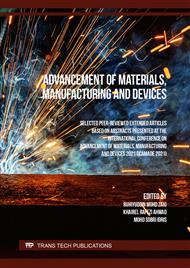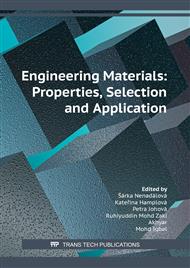p.61
p.71
p.77
p.91
p.97
p.105
p.113
p.119
p.127
Glycerolysis of Lauric Acid with Strontium Enhanced 12-Tungstophosphoric Acid Incorporated SBA-15: Material Characterization and Reusability Elucidation
Abstract:
SBA-15 was modified with strontium before being functionalized with HPW acid to investigate its performance and stability in the glycerolysis of lauric acid. The physical and chemical characteristics of the catalyst were analyzed using Fourier Transformed Infrared (FTIR), Scanning Electron Morphology (SEM), BET surface analysis, Transmission Electron Microscopy (TEM), and X-ray Diffraction (XRD). The collective evidence and finding from material characterizations, including the successfully formed and retained SBA-15 mesopores after modification twice, SrO formation and disappearance, post-SrO modification and HPW incorporation, respectively, further strengthen the claim of the strong anchoring of HPW onto the SBA-15 via the strontium-salt bridge. The reusability of the lauric acid conversion was also evaluated. The superior stability of the synthesized catalyst (HPW/SrSBA-15) was demonstrated with minimal to no change in both lauric acid conversion (75.34%) and monolaurin yield (38.9%). Such a result was attributed to the good interaction between HPW and SBA-15 via strontium modification and proved that the catalyst does not undergo severe deactivation and showed good catalytic activity in recycled use.
Info:
Periodical:
Pages:
97-104
Citation:
Online since:
August 2022
Keywords:
Price:
Сopyright:
© 2022 Trans Tech Publications Ltd. All Rights Reserved
Share:
Citation:



